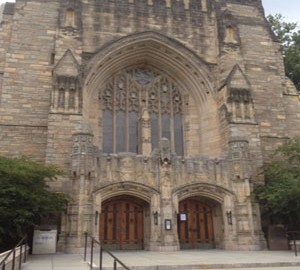Collegiate Gothic Architecture and the Ivy League
People tend to have an image of what elite institutions of higher learning should look like. For many, buildings should have massive dimensions and feature a combination of tall castle-like towers, walls of stone, stained glass, buttresses, spires, pointed arches, gargoyles, and decorated portals. This would be a college that “looks like a college”. It’s also known as Collegiate Gothic architecture.
But it wasn’t always so. For most of the 19th century, being an “old college” carried no prestige, so much of the architecture was contemporary Victorian, which looks quaint to us but was modern in its time. In addition, before the 1870s, many American colleges would have resisted a filigreed medieval style like Gothic because it looked too “papist.” But toward the end of the century, cultural and economic forces were brought to bear on American colleges that changed the appearance of campuses significantly.
Colleges began to make their case to potential donors based on their long history and traditions. Old colleges such as Harvard, Yale, Columbia, Princeton, and William & Mary were presented to donors in a way that evoked the patriotic feelings that began to grow during the Civil War and reached their peak at about the time of the 1876 centennial. Thus did the appeal of the “oldness” of colleges to patriotic fervor lead to a reverence for the age of a college.
This begs the question; “Why Gothic architecture to reflect age instead of, say, Neo-Classical or Renaissance Revival?”
American colleges had long treasured the influence of England’s Oxford and Cambridge Universities. The colleges that would become the Ivy League were meant to model them. Beginning in the late-1880s, Philadelphia architects Walter Cope and John Stewardson expanded the campus of Bryn Mawr College in an understated English Gothic style that was inspired by the architecture of Oxford and Cambridge. Cope & Stewardson followed with buildings in the same style at the University of Pennsylvania (1895-1911), Princeton University (1896-1902), and Washington University in St. Louis (1899-1909). This was the beginning of the movement known as Collegiate Gothic, which was to have a great impact on the appearance of many American colleges.
Funding was also a factor in the spread of the Collegiate Gothic style. Between the 1890s and the 1920s, American industrialists began supporting higher education with huge donations. This philanthropy allowed colleges to adopt the expensive designs representative of Oxford and Cambridge. It also allowed new colleges to build entire campuses in Collegiate Gothic style. By the turn of the century, the newer a campus was — the older it tended to look. For example, the University of Chicago, funded by a gigantic donation from John D. Rockefeller, constructed a stunning collection of Gothic towers, gargoyles and buttresses in the City’s south side on land that was donated by Marshall Field.
Of course, there are many beautiful college campuses in the United States that haven’t a single trace of Collegiate Gothic architecture. But among those that have it, certain ones have achieved striking results to evoke the image of a place suitable for higher learning. Among them are the following institutions:
| Harvard | Yale | Princeton |
| Cornell | Mt. Holyoke | Trinity (CT) |
| New York University | Kenyon College | Univ. of Chicago |
| Univ. of Pennsylvania | Brown | Boston College |
| Catholic Univ. of America | Notre Dame | City College of New York |
| Knox College | Bryn Mawr | Univ. of Pittsburgh |
| Loyola College of Maryland | Duke | Georgetown |
| Fordham | Franklin & Marshall | Augustana College |
| Carlton | Sewanee | Northwestern |
| Purdue | Washington Univ. of St. Louis | USMA West Point |
| Michigan | Reed College | Williams |
| Wesleyan (CT) | Univ. of Richmond | Wagner |
| Bard College | Vassar | Rutgers |
| Lehigh | Columbia | Indiana University |
Even some of these institutions stand out for their extraordinarily beautiful use of the Collegiate Gothic style to create outstanding campuses. A few are noted below:
- Princeton’s 500-acre campus features impressive Collegiate Gothic structures amidst spectacular green expanses.
- University of Richmond’s 350-acre grounds have red brick Collegiate Gothic buildings set among inspiring green spaces.
- Wagner College’s campus contains Collegiate Gothic architecture to rival that of the Ivy League. The Main Hall is a magnificent turreted structure that was completed in 1930.
- Boston College’s splendid Gasson Hall is one of a dozen beautiful stone Collegiate Gothic structures on the main campus.
- Bard College’s architecture aesthetically blends the old and the new with Collegiate Gothic buildings mixed with postmodern designs.
- Duke’s campus has been described as a Collegiate Gothic wonderland. The most impressive building is Duke Chapel with its towering spires.
- Washington University in St. Louis was founded in 1853. In 1905, as noted above, architects Cope & Stewardson designed its grand Collegiate Gothic buildings in the style of those at Cambridge and Oxford.
- Kenyon College campus is dominated by Old Kenyon, the earliest example of Gothic Revival architecture on an American college campus. The edifice was completed in 1829 to a design by architect Norman Nash.
- Yale’s grounds include many awe-inspiring structures, but none of them surpasses the richly decorated Collegiate Gothic Sterling Memorial Library. Completed in 1931, the library is intricately detailed inside and out, with reliefs, gargoyles, and thousands of stained-glass windows.
- Bryn Mawr’s grounds contain some of the earliest instances of the Collegiate Gothic style of architecture, which, to a great extent, served as the template for many other American campuses.
IvySelect college consultants discuss the campus environment, along with a myriad of other factors, in helping our students find the college that is right for them. We specialize in admissions to top-tier colleges. We provide superior comprehensive and individualized counseling based on years of experience in guiding students to success in meeting their educational goals.
Among our deliverables is developing a list that comprises the optimum mix of colleges to which the student will apply. A key consideration in developing the list with each student is the type of campus that the student prefers. Top-tier institutions exist in all settings, e.g., Columbia, Penn, MIT, and Chicago are big-city schools, Yale and Brown are in smaller cities, Wellesley and Stanford are suburban, and Dartmouth and Cornell are set in bucolic locales. At IvySelect, we strive to incorporate the student’s preferences, including the type of campus, in developing a target list for them.





